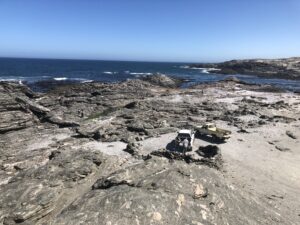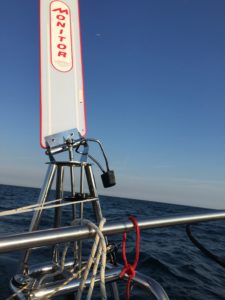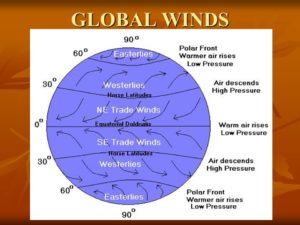After two months in South Africa, almost to the day, and of those two months, thirty-six days in Cape Town, we are sailing once again.
We are making our way up the coast to Luederitz in Namibia. And it is so cold. Yesterday a balmy thirty degrees, today foul weather gear weather to stay warm. The water below us comes straight from the Antarctic, and the wind coming off that water is cold.
We left around ten this morning, and upon leaving the harbor, we entered a fog bank. As there was no wind, we put both poles out in anticipation of getting wind from behind later on. Both poles, as this boat has three sales, the genoa up front, right behind it the staysail, and of course on the mast the main sail.
By the time we had the poles out, one sticking out to the left, the other to the right, the fog had nicely dissipated, and we could see Robben Island in the distance. We motored amidst countless fur seals towards this island, Mandela’s prison for many years. The view behind us is exactly as I will remember Cape Town, a city set in absolutely stunning surroundings. Gorgeous!
We hugged the island’s coastline and turned north after crossing the shipping lanes. But not before a penguin popped its head out of a wave, maybe ten meters from the boat. The first one for me here in South Africa. They are actually very common. I just hadn’t been out to any of the colonies. A little later, some porpoises surfed the waves, but the big entertainment was a whale having the time of its life, and although quite far away, still amazing. It was breaching and breaching and then some. At one point almost entirely out of the water.
By then the wind had picked up, blowing at about twenty knots on our beam. No need for poles here now, but the forecast was for it to move to the southwest in the very near future, shifting the wind a little more behind us. It doesn’t really matter. We’re moving quite nicely at twenty knots on just the genoa with or without a pole.
The boat, a fifty-footer built in Sweden twenty-three years ago, once owned by a writer of the original Star Trek series, is the most luxurious yacht I have had the pleasure of sailing. Everything is custom-made, from the teak deck to the beautifully finished cabinets in the galley and the staterooms.
Aft is the main stateroom with a queen size bed, ample storage space, and a roomy three-piece ensuite. It’s obviously the captain’s quarters. Ken is my age, from the UK, and a successful businessman. Unfortunately, two of his brothers and partners in ventures have passed away in recent years, and Ken is in the process of selling what is left of the business. He circumnavigated solo most of the way, got stuck in Indonesia during Covid, and has now taken on two crew for the last leg back to England.
Just north of the main common area is a hallway leading to the v-berth. On the right is the head, toilet, sink, and shower. On the left is a tiny room with a bunk bed. My room. Only a foot of space between the door and the bunk, just enough to get dressed, but I can completely stretch out on the bed without touching the walls. I’m very pleased with my quarters.
Maaike sleeps in the v-berth, at least as long the waves aren’t too bad. She’s from Amsterdam, turning fifty this year. A very well-traveled lady, working for a Dutch tour operator worldwide. She just returned from Rwanda and spent months in southern Africa before that. Now she takes a few months to see if she likes sailing. She’ll probably leave the boat in the Azores to get back to work. The first assignment will take her to Japan. A little seasick at the start, but already getting over it.
And then there is Tiki the sailor cat, a fine looking animal that has Ken completely wrapped around her paw. She got on board in Indonesia and does not leave the boat. Ken put her on the dock in Cape Town, but she wouldn’t have any of it. She instantly jumped back on the boat, which really is Ken and Tiki’s home, as he sold his house in London and does not plan to buy a new one. Ken and Tiki are liveaboards.
The Atlantic Ocean, now cold, but will be warming up going north. The days will get shorter until we hit the equator and then lengthen when we transit from a southern hemisphere fall into a northern hemisphere spring.


